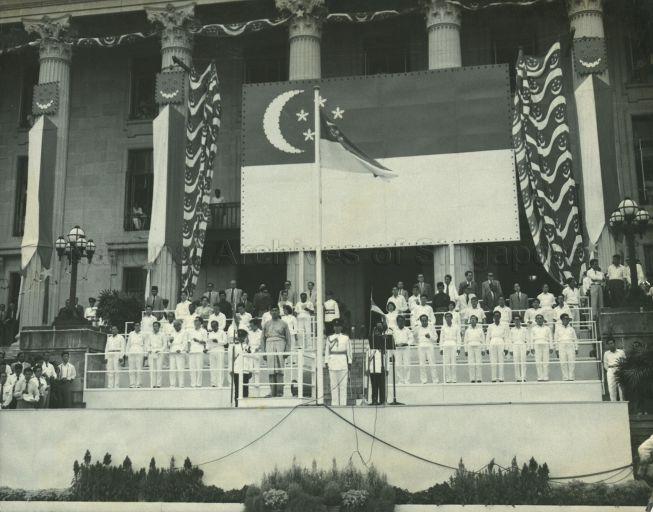Tell me to represent Singapore in a symbol, and invariably the Rising Stars and Crescent come to mind. Red and White. Majulah. These symbols are important—that has never been in doubt. But as we revel in the spirit of National Day in Singapore, what can we learn from the way we treasure these symbols every year? Can we appreciate their value?
$56, $5,600 or $56,000. What if I told you Majulah Singapura cost 56 million dollars to compose and write. Or 56 cents? I think it wouldn’t change its intrinsic value to the country. The number simply does not matter: because if we’re valuing symbols with just money, we blind ourselves to their other priceless attributes. (In case you’re wondering, Zubir Said was never paid a cent for composing Majulah Singapura. He did get a road named after him though, amongst many other accolades.)
As a brand consultancy, these are what I think are the key factors that give a symbol its value. They are not ordered by importance, but rather by how each builds off the previous.
The Value of Relevance
“The symbols we have had so far were symbols that emphasised our subjection to the will of others. They were symbols of dominance, of authority imposed from the outside.”
Former Minister for Culture, Mr. S. Rajaratnam
When the British left in 1959, creating our own identity was of paramount importance. A new beginning called for a reflection of who Singapore is and what the nation stood for. Then, it was necessary to rally everyone, regardless of creed, together as one common people. Symbols were the first and most important means to rally a disparate people as one.
But, “We couldn’t get the loyalty of the people if we told them to salute the Union Jack or sing God Save the Queen.” (Dr Toh Chin Chye)
Certainly none of that is relevant to Singapore, other than a reminder that it was a colony of a completely foreign power. That’s not exactly something anyone would be proud of. From understanding our place in geography when designing our flag, to intentionally using Malay in our national anthem, Singapore took tremendous care to ensure our symbols meant something to us.
Thus, symbols start earning its value from its relevance. They must make sense to the people who use it or stand by it, must reflect who they are now, and who they want to become.
“Now that Singapore is a self-governing state it is right and proper that it should have its own symbols of authority and loyalty. Only through these new symbols can we express the spirit that today moves our people.”
Former Minister for Culture, Mr. S. Rajaratnam

The Value of Power
Symbols are more than just passive markers, labels or badges of identity. More often than not, they play an active role in stirring emotion, emboldening action and rallying individuals to common unity.
“I was determined to be different – to compose an anthem which is stirring to the youth and which embodies the spirit of challenge.”
Zubir Said, composer of the National Anthem

Take seeing the flag flypasts every 9th of August. Or when the swell of Majulah Singapore rouses the crowd during the parade. That fleeting sense of pride (however big or small), is the power of the symbol. But the real effect is to mobilise people, through the power of emotion, towards a grander purpose. In Singapore’s case, that’s to build a democratic society based on justice and equality so as to achieve happiness, prosperity and progress.
That power—to rouse people towards purpose—is the next key factor that give symbols their value.
The Value of Skill
A symbol can only have relevance and power if it is made with care. I believe this lies in accepting only high level of skill in their creation, and conscious discipline to use these symbols with respect and reverence, consistently. Indeed, much of design, music, and words is art. But what use is a paintbrush without a steady hand, or an instrument without its maestro?
There are objective standards that must pass if a symbol is to have any relevance or power, and it takes experience, skill and professionalism to achieve that. I believe the commitment to apply skill creating such symbols is itself a symbol: that commitment signals respect, sincerity and pride in the work.
“You have to adapt yourself to their customs and traditions, which means where you put your foot on the soil and then you must give your goodwill to that place.”
Zubir Said, composer of the National Anthem
Thus, the amount of skill, thought and craftsmanship that was applied in creating the symbol is the third key factor behind the value of any symbol.
The Value of Artistry
“I got a free hand with no limitations or constraints.”
Zubir Said, composer of the National Anthem
True masterpieces are never created by committee. It’s a difficult balance, because in the same vein, good artists copy, while great artists steal. Outside influence is inevitable, but the lead direction must come from an artistic visionary. The question then, is the amount and nature of freedom granted to the artist to realise that vision. Were the outside influences compromises, or constructively enhancing?
Zubir Said was given incredible autonomy in composing the national anthem. Apart from a clear brief and practical feedback (shorten the song), to entrust the song of a nation entirely in the hands of the creative professional is something many organisations today often lack the balls to do. What this gives birth to, is a creation that can be considered an iconic piece of culture—more than just a symbol, it has the power to be treasured and to be uniquely ….
For a symbol to effectively embody the values of relevance, power and skill, there must be that artistry in it—a je ne sais quoi or talent that is invariably god-given and free to manifest.
Thus, a symbol earns value too in the amount of artistic freedom allowed in its creation.
The Value of… Money
In the end, we must come back to this. Whether we like it or not, we cannot ignore the importance of money when it comes to the value of a symbol. But we must tread wisely: Free doesn’t mean worthless, and expensive doesn’t mean valuable.
“I considered it was a sin to accept anything materialistic.”
Zubir Said, composer of the National Anthem
When developing something as important as a symbol, money should never be the paramount consideration. Rather, monetary cost should be merely a guide. The numbers simply help us better understand and appreciate the other factors like relevance, power, skill and artistry. And then, we must weigh how it can be applied to enable all of these factors.
Without going too deeply into financial principles, these monetary costs (whether high or low) forces us to think more deeply about the process. With limited resources and unlimited expectations, what can we reasonably achieve? Are the dollars we pay a sunk cost, or an investment in future value? Thus, the value of a symbol in terms of money can only be seen when you evaluate every other factor of value.
Most of the time, the resultant symbols acquire even greater value after decades of use, reverence and celebration. It becomes invariably tied to culture and identity, whether of the nation or a business. This value, in the end, is priceless beyond the sum of all its parts.





